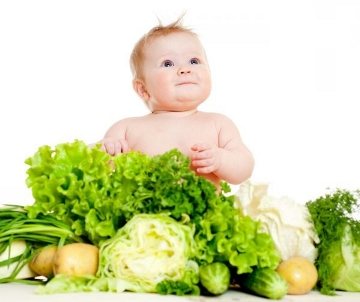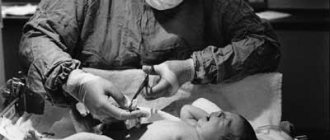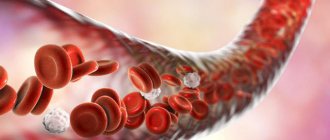A decrease in hemoglobin levels in children is indicated by symptoms such as irritability, tearfulness, frequent illness, apathy and weakness. It is important to identify the deviation in a timely manner and take action to increase the child’s hemoglobin. This condition can be congenital and develop during fetal development.
In other cases, low hemoglobin level is an acquired blood disorder that developed in the child after birth due to exposure to various factors.
How to help a newborn?
The first two months a newborn actively uses up the supply of hemoglobin that it received from its mother during intrauterine development. Subsequently, reserves are depleted and the level decreases. This happens by 3-4 months.
During this period, it is extremely important that the baby receives everything necessary for the synthesis of hemoglobin from food. The ideal option is breastfeeding. With mother's milk, the baby will receive everything he desperately needs.
A nursing mother should include increased amounts of iron-containing foods in her daily menu. These include beets, apples, buckwheat, meat, pomegranates, carrots, and tomatoes.
Limit foods that remove iron from the body: all types of tea, coffee, fresh milk.
A nursing mother is prohibited from strict diets that deplete the body's iron supply and lead to a decrease in hemoglobin levels. Following these recommendations will allow you to maintain all blood counts within normal limits and also avoid taking medications.
How to increase hemoglobin in a breastfed baby
Every effort must be made to establish breastfeeding, and for the first months (or even years) of the baby’s life, breastfeed. This will be the best prevention of anemia in a child. Immediately after birth, you need to put the baby to the breast, then colostrum, once in the baby’s intestines, will start the normal functioning of the gastrointestinal tract. Thus, the intestinal cells will learn to absorb all the necessary substances from food, including iron. If you breastfeed your baby, he will get everything he needs from your milk. According to one version, the mother’s nutrition does not even matter for the composition of human milk. In any case, iron will be secreted in the volume required by the child and will be almost completely absorbed from the digestive tract.
Nevertheless, the mother needs to monitor her diet, at least in order to replenish the supply of substances necessary for her health. To maintain normal hemoglobin levels, it is necessary to consume foods containing iron in sufficient quantities. And it is not at all necessary that these are products of animal origin.
Here are the top foods that are leaders in iron content:
- Turmeric, spirulina.
- Green sprouted buckwheat.
- Pomegranate and beets.
- Green apples.
- Sea kale.
- Pumpkin seeds, flax.
- Dried apricots.
- Spinach.
- Walnuts.
- Rose hip.
- Lentils and beans
It is important to know that there are rules for taking iron:
— vitamin C helps its absorption (you can, for example, cook lentils with broccoli or add lemon);
- calcium complicates the absorption of iron, as it slows down its absorption;
- Tea and coffee are also not advisable if you want to maintain healthy hemoglobin levels, as they flush iron from the body.
Monitoring hemoglobin during the introduction of complementary foods
If your baby’s levels are low, you shouldn’t rush to use medications that artificially replenish iron deficiency. First, you should try to solve the problem by normalizing the baby’s diet.
Fruit juices are rich in iron. But you shouldn’t introduce them to your child’s menu too early. This will negatively affect the functioning of the stomach and intestines. Better pay extra attention to the meat. This is the No. 1 product for anemia in children.
If a child’s hemoglobin cannot be increased, then he needs to be introduced to complementary foods earlier than usual, at 5.5 months. The peculiarity is that the meat is introduced almost immediately after the introduction of the first vegetables. Give preference to turkey or rabbit meat, and later expand your diet with beef.
Buckwheat is considered a valuable source of iron. But it cannot replace meat.
Iron, which is contained in animal products, is absorbed faster and better! Meat should be present in the diet of children with low hemoglobin levels every day.
How to increase hemoglobin in an infant

How to increase hemoglobin in a baby whose main food product is breast milk? A nursing mother should follow a diet that includes iron-containing foods, such as meat (rabbit, turkey, chicken, lean beef), liver, fish, buckwheat, legumes, wheat flour products, dried fruits and nuts. When choosing vegetables, you should give preference to baked potatoes, beets, carrots, tomatoes, herbs and pumpkin. Fruits will also be useful - green apples, plums, apricots, pomegranates. Berries - black currants, cranberries, strawberries and wild strawberries - will help increase low hemoglobin levels.
Despite the undeniable benefits of these products, we must not forget about the possible sensitivity of the child’s body. Therefore, when introducing them into your diet, you need to consult a doctor, and then carefully monitor the baby’s reaction.
Timely and competent introduction of complementary foods - vegetables, fruits, cereals, meat and offal - will help increase hemoglobin levels in children from six months of age. For babies who have low hemoglobin from birth, it is advisable to introduce complementary foods a little earlier than six months and start with vegetables and fruits.
In cases where proper nutrition does not bring the expected results, the doctor may additionally prescribe hemoglobin-increasing drugs. In this case, it is necessary to check with the doctor at what time and how to give this or that drug, since food can block the effect of some medications. Parents should also closely monitor the child’s reaction to the prescribed medications and inform the doctor about the occurrence of such adverse reactions as:
- pain in the upper part of the peritoneum; constipation; loose and dark stools; nausea.
It is better to give preference to drugs in the form of drops, they are absorbed quite well and do not cause such side effects as other dosage forms. Intramuscular administration of drugs to increase hemoglobin in children is extremely rare.
Treatment with drugs is quite quick - it will take about a month to normalize hemoglobin levels, then you need to repeat the blood test. Based on its results, the doctor decides on the advisability of further use of medications.
Low hemoglobin
In the first time after birth, low hemoglobin in infants is the consequence of improper nutrition of the mother, since the baby receives hemoglobin from the female body. Therefore, it is of great importance how well the baby’s mother eats and gets enough sleep. A nursing mother should eat red meat, vegetables, fish and seafood in general, liver, soybeans, legumes, bananas, in a word, her diet should be varied. It is understandable to want to get your body and figure in order after childbirth, but sharply limiting yourself in nutrition is far from the best solution.
Also, the level of hemoglobin in a newborn is affected by infectious diseases of the mother. If a woman’s body lacks iron, for example, after a difficult birth or as a result of exacerbated chronic diseases, then the baby needs complementary foods. Otherwise, he will be left without the required amount of hemoglobin, and this will certainly affect his health.
Premature babies may also have a lack of hemoglobin. In some cases, low hemoglobin is also one of the side effects of postmaturity.
During a multiple pregnancy, the mother does not have enough hemoglobin for everyone, so the child will need to be given iron supplements. To avoid this, you need to pay more attention to the health of the pregnant woman and her diet. It is important that a woman eats not only in sufficient quantities, but also in a varied diet. Keep in mind that any problems with immunity can negatively affect hemoglobin levels in infants. When babies are born, it is necessary to monitor whether they have enough milk. If not, complementary foods should be introduced, and in some cases even from the first days after birth.
High hemoglobin
It happens that a baby’s hemoglobin level is many times higher than normal. High hemoglobin in children is observed with cardiopulmonary failure, intestinal obstruction, blood disease and congenital heart disease. Until the age of three months, there is no need to panic, but if the hemoglobin level remains elevated in the future, you need to consult a doctor.
The fact is that high hemoglobin can slow down the baby’s development, so it is very important to identify the problem in time and eliminate it.
Parents should remember that if a child’s hemoglobin is high or low, it is important to promptly identify the problem and take measures to eliminate it.
Why does the hemoglobin concentration decrease?
A low hemoglobin level in childhood can be a consequence of:
- insufficient synthesis due to low iron levels;
- acute blood loss (case of injury), chronic (frequent nosebleeds, heavy periods). This type of anemia is called posthemorrhagic;
- increased destruction of red blood cells due to the negative effects of toxins, the current disease. In this case, the patient is diagnosed with hemolytic anemia.
Children are most susceptible to iron deficiency anemia. The following reasons for its development are identified:
- During intrauterine development, the fetus accumulates iron from the mother's body, which after the birth of the baby ensures the correct synthesis of hemoglobin. But these reserves are enough for 5-6 months.
- If the expectant mother suffered from anemia, then the child will already be born with iron deficiency. As a rule, anemia will occur in the first six months. In a pregnant woman, pathology develops against the background of poor nutrition, infectious diseases and bad habits.
- During the period 6–12 months of a baby’s life, iron levels depend on the quality of breast milk consumed. Milk itself contains little of this substance, but the existing protein ferritin ensures good absorption of iron.
- Insufficient intake from food. Approximately 5 percent of iron leaves the body through feces, so its supply must be constantly replenished. In the first half of the year, the baby rapidly gains weight, so his body needs hemoglobin and iron. If food contains insufficient amounts of the latter, anemia develops.
- Diseases of the digestive organs: gastritis, duodenal and stomach ulcers, enteritis.
- Vitamin B12 deficiency.
- Artificial feeding with cow's, goat's milk, semolina instead of special baby food interferes with the absorption of iron, since it turns it into an insoluble substance. The development of anemia is caused not only by low iron content, but also by intestinal bleeding that occurs due to the consumption of unadapted dairy products. Experts have not established the exact cause of the bleeding. Most likely, due to the intolerance of the child's body to cow's milk protein. As the child develops, the manifestations decrease, and by the age of two they disappear completely.
- Previously, incorrect introduction of complementary foods.
Increased hemoglobin

The following indicators, depending on the child’s age, indicate that your little one’s hemoglobin is higher than the norm:
- in babies up to two weeks - over 200 g/l;
- in a baby from two weeks to a month - over 180 g/l;
- in a child from one to two months - over 130 g/l;
- from two months to five years - more than 140 g/l;
- from five to twelve years – more than 145 g/l;
- from twelve to eighteen years, girls - more than 152 g/l, boys - more than 160 g/l.
How else can you increase hemoglobin in an infant?
An important factor in the treatment of anemia in infants is the normalization of the daily routine. Provide your baby with adequate sleep, long walks in the fresh air (1.5–2 hours a day), the opportunity to move a lot, and strengthen him. These factors also play a significant role in increasing hemoglobin.
Among some naturopaths there is still an opinion that the child’s hemoglobin is influenced by the emotional state of the mother. According to this theory, if a mother is full of fears, then these fears block the flow of life (which is equivalent to the flow of blood) both through her channels and through the channels of the child. If there is no place for joy and a smile in her life, but there is a lot of anger and resentment, then changing her diet will most likely not change anything. If you find a resource of inner joy in yourself, stop “spoiling” your blood, stop sorting things out with your family, then this is how you can increase your baby’s hemoglobin.
source











